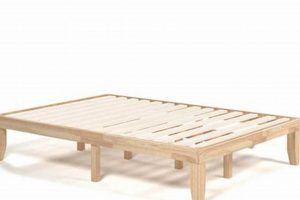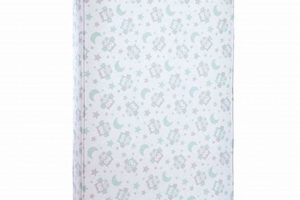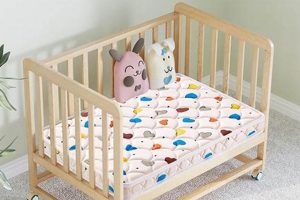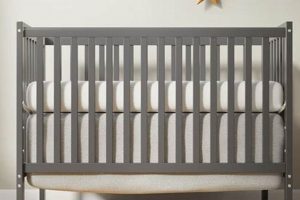The dimensions of bedding specifically designed for infant sleeping surfaces are critical for safety and comfort. These measurements ensure a snug fit, preventing loose fabric that could pose a hazard to the child. Standard dimensions are typically around 28 inches wide by 52 inches long, accommodating the common interior size of a standard crib. A properly sized product eliminates bunching or slipping, contributing to a secure and restful environment.
Selecting the appropriate dimensions is crucial for infant safety standards. A properly fitting cover minimizes the risk of entanglement and suffocation. Historically, variations in crib construction necessitated a wider range of bedding sizes. However, standardization in crib manufacturing has led to a more consistent size requirement, simplifying the selection process and enhancing safety protocols. This contributes to better sleep quality and reduced parental anxiety.
The following sections will delve into specific considerations for choosing infant bedding, including material types, safety certifications, and practical tips for ensuring a secure and comfortable sleep environment. Understanding these details will equip caregivers with the knowledge necessary to make informed decisions regarding their child’s sleep space.
Ensuring Proper Fit
Selecting the correct bedding for infant sleep surfaces is paramount for safety and optimal comfort. Adherence to established guidelines minimizes potential hazards. The following recommendations offer practical advice for ensuring a secure fit.
Tip 1: Verify Dimensions: Always confirm that the product’s labeled measurements precisely match those of the infant’s sleeping surface. Minor discrepancies can compromise safety.
Tip 2: Check for Snugness: After application, the bedding should fit tightly with no discernible slack. Excess material can create a suffocation risk.
Tip 3: Inspect Elastic Quality: If equipped with elastic edging, ensure that the elastic is robust and maintains its shape. Degraded elastic can lead to a loose fit over time.
Tip 4: Prioritize Fitted Styles: Fitted products offer a more secure fit compared to flat alternatives, reducing the likelihood of displacement during sleep.
Tip 5: Avoid Overly Thick Fabrics: Excessively thick materials can compromise airflow. Opt for breathable fabrics that promote ventilation.
Tip 6: Regularly Inspect for Wear: Routinely check the bedding for signs of wear and tear, such as holes or fraying. Damaged products should be replaced immediately.
Tip 7: Wash Before First Use: Washing the bedding before its initial use can help to pre-shrink the fabric and ensure a better fit after subsequent washings.
By consistently applying these guidelines, caregivers can significantly enhance the safety and comfort of their child’s sleep environment. A properly fitted sheet eliminates potential hazards and contributes to more restful sleep.
The concluding section will summarize the key points discussed and offer further resources for ensuring a safe sleep environment for infants.
1. Standard dimensions (28×52 inches)
The measurement of 28 inches by 52 inches represents the conventional standard for infant sleep surfaces. This dimension serves as the foundation for producing adequately sized bedding, ensuring both safety and proper fit. The relationship between this size and appropriately-sized bedding is critical in preventing potential hazards.
- Safety Compliance
The 28×52 inch standard facilitates adherence to safety regulations established by organizations such as the Consumer Product Safety Commission (CPSC). Bedding designed within these parameters reduces the risk of entrapment or suffocation. Manufacturers must meet these size specifications to ensure compliance and protect infants.
- Manufacturing Standardization
The uniform dimension streamlines manufacturing processes, allowing bedding producers to create products compatible with the majority of infant beds. This standardization simplifies inventory management and enables retailers to offer a consistent range of bedding options, improving consumer access.
- Fit Consistency and Comfort
A correctly sized covering, adhering to the 28×52 inch standard, ensures a snug fit without excessive looseness. This promotes a secure and comfortable sleep environment. Ill-fitting products may bunch or slip, causing discomfort or potential hazards during sleep.
- Retail Availability and Consumer Choice
The widespread adoption of the standard dimensions for bedding has increased the availability of diverse bedding options. Consumers benefit from a broader selection of materials, patterns, and features designed to fit the standard size. This enhances purchasing power and allows for more personalized choices.
The adherence to the 28×52 inch measurement is integral to ensuring the safety, consistency, and accessibility of coverings for infant sleep surfaces. The standardized dimension facilitates compliance, streamlines manufacturing, and enhances consumer choice, contributing to a safer and more reliable market for infant bedding products.
2. Fitted sheet elasticity
Fitted sheet elasticity represents a critical component of appropriately sized coverings for infant mattresses. The elasticity, or the ability of the sheet’s edges to stretch and retract, directly impacts the fit and security of the bedding on a standard 28×52 inch mattress. Insufficient elasticity may result in a loose fit, while excessive elasticity can lead to premature wear and tear. The proper degree of elasticity ensures that the sheet remains taut, minimizing the risk of bunching or detachment, both potential hazards.
The functionality of fitted sheet elasticity can be demonstrated through practical scenarios. A sheet with inadequate elasticity might slip off the corners of the mattress during infant movement, creating loose fabric that poses a suffocation risk. Conversely, a sheet with optimal elasticity maintains a secure grip, even with regular washing and infant activity. Real-life examples underscore the importance of evaluating elasticity by stretching the elastic band before use and monitoring its performance over time. A loss of elasticity indicates the need for replacement.
Understanding the relationship between elasticity and mattress dimensions is paramount for ensuring a safe sleeping environment. The elasticity must be sufficient to accommodate the mattress’s thickness and dimensions, while also retaining its shape and tension over repeated use and cleaning cycles. In summary, appropriate fitted sheet elasticity is a non-negotiable element of correctly sized infant bedding, contributing directly to infant safety and parental peace of mind. Ensuring correct elasticity mitigate a potential hazard.
3. Material shrinkage rate
Material shrinkage rate represents a significant factor influencing the ultimate dimensions and fit of a sheet designed for a standard infant mattress. The initial dimensions of the fabric are calculated to account for the anticipated reduction in size following the initial laundering. Failure to consider this shrinkage can lead to bedding that no longer conforms to the required 28×52 inch specifications, potentially compromising safety. This effect is most prominent in natural fibers, such as cotton, which are commonly selected for their breathability and comfort. A high shrinkage rate can result in the sheet becoming too small, pulling away from the mattress corners and creating a loose or hazardous sleep surface.
Real-world implications of neglecting the material shrinkage rate include increased parental expenditure due to the necessity of replacing bedding that no longer fits correctly. For instance, a newly purchased sheet may initially fit the mattress properly, but after the first wash cycle, it could shrink by several inches, rendering it unusable. To address this issue, manufacturers often pre-shrink fabrics or provide specific care instructions designed to minimize further shrinkage. Consumers should carefully review these instructions and select bedding from reputable brands that account for expected dimensional changes.
In conclusion, understanding and accommodating the material shrinkage rate is essential for maintaining the correct dimensions of infant mattress coverings. Manufacturers must accurately predict shrinkage and adjust initial fabric dimensions accordingly. Consumers, in turn, must diligently follow care instructions and consider pre-shrunk options to ensure a safe and appropriately sized sleep surface for their infant. This attentiveness ultimately mitigates the risks associated with ill-fitting bedding and promotes a secure sleep environment.
4. Corner pocket depth
Corner pocket depth is a critical dimension in relation to properly sized crib sheets. It dictates how securely the sheet attaches to the mattress, directly affecting safety and comfort. Inadequate pocket depth can cause the sheet to slip off, while excessive depth may result in a loose, potentially hazardous fit. Therefore, appropriate corner pocket depth is essential when selecting bedding for a standard infant mattress.
- Mattress Thickness Accommodation
Corner pocket depth must correspond to the thickness of the mattress. Variations in mattress thickness necessitate careful consideration when selecting bedding. A pocket that is too shallow will not adequately cover the mattress corners, while one that is too deep may create excess fabric that could pose a risk.
- Elastic Band Integration
The design and placement of the elastic band are intrinsically linked to the effectiveness of the corner pocket. A well-positioned elastic band, combined with the appropriate pocket depth, ensures a snug and secure fit around the mattress corners, preventing slippage during infant movement.
- Fabric Tension and Stress
The pocket depth influences the tension exerted on the fabric. Insufficient depth can overstretch the material, leading to premature wear and potential tearing. Conversely, excessive depth may cause the fabric to bunch, creating uneven surfaces. Optimal pocket depth evenly distributes tension, enhancing both durability and comfort.
- Compliance with Safety Standards
Corner pocket depth contributes to the overall safety of crib bedding. Compliance with safety standards, such as those set by the CPSC, requires bedding to fit securely and prevent hazards. A properly designed corner pocket, in conjunction with the sheet dimensions, is essential for meeting these standards.
In summary, the dimensions of crib sheets are incomplete without consideration of the corner pocket depth. This seemingly minor detail significantly impacts the sheet’s ability to securely and safely fit the mattress. Attention to corner pocket depth, in conjunction with other factors, contributes to a secure and comfortable sleep environment for infants.
5. Fabric breathability
Fabric breathability, as it pertains to coverings for infant mattresses, is inextricably linked to the concept of appropriate sizing. The materials ability to allow air circulation directly influences the infant’s body temperature and reduces the risk of overheating, a factor linked to Sudden Infant Death Syndrome (SIDS). Therefore, fabric breathability is not merely a comfort consideration but a critical safety component within the parameters of correctly sized infant bedding. An ill-fitting sheet, regardless of its breathability, compromises safety if it restricts movement or creates loose folds. Conversely, a properly sized sheet constructed from non-breathable material can still pose a threat of overheating. Thus, the dimensions of the sheet must complement, not negate, the properties of the fabric. As an example, a tightly fitted sheet made of a synthetic, non-breathable material can trap heat and moisture, leading to discomfort and increased risk.
The practical significance of understanding this connection lies in informed consumer choices and manufacturer design considerations. Parents and caregivers need to actively seek out coverings crafted from materials like cotton, muslin, or bamboo, which exhibit superior breathability. Simultaneously, manufacturers should prioritize both appropriate dimensions and fabric composition, undergoing testing to ensure their products meet established safety standards regarding airflow and temperature regulation. Retailers also play a critical role in educating consumers about the importance of selecting bedding that balances fit and breathability. Educational displays and informative product descriptions can contribute to safer purchasing decisions.
In conclusion, fabric breathability is an essential consideration that cannot be divorced from the overall concept of correctly sized infant coverings. While achieving a snug and secure fit is paramount, neglecting the fabric’s ability to facilitate airflow undermines the intended safety benefits. Challenges remain in establishing universally accepted standards for breathability testing and in ensuring consistent labeling practices. However, prioritizing both dimensions and material properties remains crucial for creating a safe and comfortable sleep environment for infants, contributing to the overarching goal of reducing SIDS risks.
6. Thread count impact
Thread count, defined as the number of horizontal and vertical threads per square inch of fabric, is often perceived as an indicator of quality and softness in bedding. However, its impact on infant bedding, specifically in relation to correctly sized sheets, requires careful consideration. While a higher thread count may suggest a smoother texture, it is not the sole determinant of safety or suitability for infant use. The relationship between thread count, breathability, and overall construction directly influences the suitability of bedding for use with standard crib mattress dimensions.
- Breathability and Overheating Risk
An excessively high thread count can reduce fabric breathability, potentially increasing the risk of infant overheating. Densely woven fabrics, while soft, restrict airflow, which is a critical factor in regulating an infant’s body temperature. Lower thread counts or more loosely woven fabrics often provide superior ventilation, mitigating the risk of overheating, particularly when combined with appropriate layering of clothing and room temperature control.
- Fiber Type and Weave Structure
The impact of thread count is inextricably linked to the fiber type and weave structure of the fabric. For instance, a cotton sheet with a moderate thread count may be more breathable and softer than a polyester sheet with a significantly higher thread count. Similarly, percale and muslin weaves, even with relatively low thread counts, offer excellent breathability and are often preferred for infant bedding. A focus solely on thread count neglects these crucial material properties.
- Durability and Longevity
While a higher thread count may suggest increased durability, this is not always the case, especially with lower-quality fibers. The quality of the yarn and the manufacturing process are equally important. In the context of infant bedding, durability is important, as frequent washing is necessary to maintain hygiene. However, durability should not come at the expense of safety and breathability.
- Safety Certifications and Material Composition
Thread count should not overshadow the importance of safety certifications and material composition. Certifications such as OEKO-TEX indicate that the fabric has been tested for harmful substances and is safe for infant contact. Regardless of the thread count, prioritizing certified organic cotton or other natural fibers minimizes the risk of skin irritation and exposure to potentially harmful chemicals.
In summary, thread count is but one factor to consider when selecting coverings for infant sleep surfaces. While a comfortable texture is desirable, breathability, fiber type, weave structure, and safety certifications should take precedence. An informed decision balances thread count with other material properties to ensure a safe and comfortable sleep environment that aligns with established recommendations for infant care.
7. Safety certifications (e.g., OEKO-TEX)
Safety certifications, exemplified by OEKO-TEX, establish a critical benchmark for textiles used in infant bedding, assuring the absence of harmful substances. These certifications directly relate to crib mattress bedding dimensions by ensuring that materials meeting size requirements also adhere to strict safety standards, creating a holistic approach to infant well-being.
- Chemical Residue Limits
Certifications impose stringent limits on chemical residues permissible in fabrics. OEKO-TEX, for instance, tests for pesticides, heavy metals, and formaldehyde. In the context of infant bedding for standard-sized mattresses, these limits ensure that the sheet, while fitting correctly, will not expose the infant to harmful chemicals through skin contact or inhalation.
- Material Composition Verification
Certification processes verify the material composition declared by manufacturers. This is crucial as some materials, while potentially meeting size specifications, might contain synthetic components or dyes that are not safe for infant use. Certified products offer assurance that the materials align with specified standards, regardless of the mattress dimension.
- Durability and Washability Testing
Many certifications include tests for durability and washability, assessing the fabric’s ability to withstand repeated laundering without compromising safety. Given that infant bedding requires frequent washing, certified products provide confidence that the material will maintain its integrity and continue to meet safety requirements even after multiple cleaning cycles, irrespective of the sheet’s size.
- Traceability and Supply Chain Transparency
Some certifications require traceability throughout the supply chain, enabling consumers to verify the origin and processing of the materials used in the bedding. This transparency allows for greater accountability and assurance that the product meets ethical and environmental standards, in addition to safety requirements, regardless of mattress covering measurements.
The intersection of safety certifications and crib mattress bedding dimensions highlights a comprehensive approach to infant care. Certifications ensure that bedding not only fits correctly but also adheres to rigorous safety standards, providing parents and caregivers with assurance regarding the health and well-being of their children.
Frequently Asked Questions
The following questions and answers address common concerns and misconceptions regarding the proper selection and use of infant mattress bedding. Adhering to established guidelines is crucial for ensuring infant safety and optimal comfort during sleep.
Question 1: What are the standard dimensions for crib mattress bedding?
The industry standard dictates dimensions of approximately 28 inches in width by 52 inches in length for coverings designed to fit standard infant sleep surfaces. Adherence to these measurements is paramount for preventing hazards associated with ill-fitting bedding.
Question 2: How does material shrinkage affect the fit after washing?
Natural fibers, such as cotton, are prone to shrinkage after laundering. Selecting pre-shrunk materials or accounting for potential dimensional changes during washing is crucial for maintaining a secure and appropriate fit over time.
Question 3: What level of fitted sheet elasticity is considered safe?
The elastic edging on a fitted covering should be robust enough to ensure a secure fit around the perimeter of the infant’s sleep surface, without being so tight that it distorts the shape of the mattress or creates excessive tension.
Question 4: How does corner pocket depth impact overall safety?
The depth of the corner pockets should adequately accommodate the thickness of the infant’s mattress. Insufficient depth can lead to slippage, while excessive depth may result in loose fabric, both of which present potential safety hazards.
Question 5: Does thread count directly correlate with product safety?
While thread count can influence fabric softness and durability, it is not the primary determinant of safety. Breathability, material composition, and adherence to safety certifications are of greater importance when selecting bedding.
Question 6: What safety certifications are most relevant when purchasing covers for an infant mattress?
Certifications such as OEKO-TEX Standard 100 indicate that the bedding has been tested for harmful substances and meets established safety criteria. Prioritizing certified products can provide added assurance regarding material purity and safety.
Prioritizing correctly sized and certified bedding is paramount for mitigating potential hazards and promoting infant well-being. Consistent adherence to established safety guidelines ensures a secure and comfortable sleep environment.
The concluding section will summarize the key points discussed and offer resources for ensuring a safe sleep environment for infants.
crib mattress sheet size
This exploration has emphasized the critical role of proper dimensioning in bedding specifically designed for infant mattresses. Key considerations include adherence to standard measurements, material shrinkage rates, elasticity of fitted edges, corner pocket depth, fabric breathability, the impact of thread count, and the importance of safety certifications. Each of these elements contributes to a secure sleep environment and mitigates potential hazards.
The selection of bedding is a responsibility that demands diligence and awareness. A commitment to informed purchasing decisions and rigorous adherence to safety standards is essential for safeguarding infant well-being. Further research and continuous monitoring of evolving safety guidelines are encouraged to ensure a secure and comfortable sleep environment for all infants.







